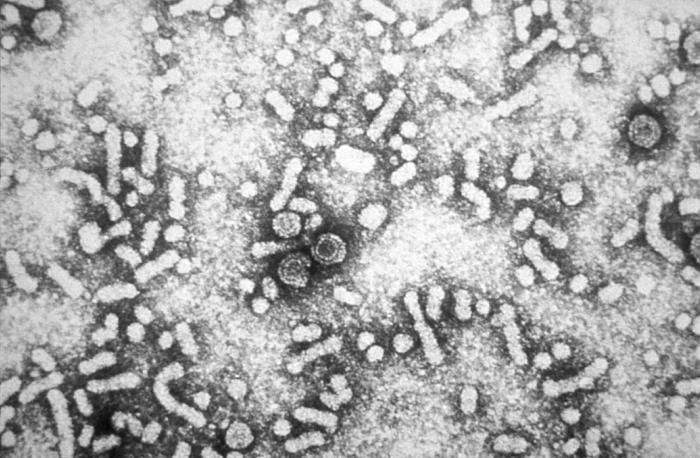Playlist
Show Playlist
Hide Playlist
Hepatitis B
-
Slides GIP Viral Hepatitis.pdf
-
Reference List Pathology.pdf
-
Download Lecture Overview
00:02 That's Hepatitis A. 00:03 Let's move on to hepatitis B. 00:05 So it is a partially double stranded, hepadnavirus. 00:10 It is a blood-born pathogen. 00:12 And interestingly, compared to say HIV, it's about 100 times more infectious. 00:19 So a needle stick with Hepatitis B is much more likely to be transmitted to you as a healthcare provider than HIV by about 100 fold. 00:29 There is also vertical transmission that is from mother to fetus, and sexual transmission that can occur. 00:38 Typically, typically, most Hepatitis B is an acute self limited infection. 00:43 In 95% of adults, they will get it, they will clear it in they're good to go. 00:49 If you are so unfortunate to be a child and get it, they don't clear it quite as effectively. 00:54 So the incidence of a chronic hepatitis B infection goes up, if the infection occurs at a younger age. 01:02 And if you happen to get it as a neonate, most cases 95% of cases will develop a chronic hepatitis. 01:10 Overall, with the acute infection, there's very low morbidity mortality, less than 1% risk of acute fulminant liver failure, it does occur, which is unfortunate, but it's a very low risk overall. 01:23 Chronic infection does occur, so about 5% of the world's population don't really develop a good clearing immune response. 01:33 So that they will constantly be infected at some low level and can potentially transmit disease. 01:40 These patients depending on the amount of associated inflammation can also progress to cirrhosis, and eventually hepatocellular carcinoma. 01:48 There are extrahepatic manifestations with Hepatitis B that we don't see with hepatitis A and hepatitis B because you can if you're a chronic carrier, you have chronic active infection. 01:58 You are making virus and viral antigens, and your immune system is making antibodies to those antigens. 02:06 And you can have immune complex deposition as a consequence. 02:10 So for example, about 20% of patients who have polyarteritis nodosa. 02:15 This is an immune complex driven vasculitis, 20% of those patients actually have chronic active hepatitis B. 02:24 There is a vaccine available. 02:26 And for most of you, vast majority of you watching this, you will have gotten that in high school or college. 02:33 And certainly they will want you to have it before you start taking care of patients, when you are at risk of potentially getting infections from a needle stick. 02:42 So the laboratory diagnosis is based on a number of the proteins that the virus makes. 02:48 So there is a surface antigen or sAg. 02:52 And we develop antibodies specifically to that. 02:55 There is an inner core that is around the partially double stranded DNA. 02:59 Those are called C antigens or core antigens. 03:02 And then there's an E antigen that kind of sits in between the core and the surface. 03:08 And those proteins aren't necessary for viral replication, or infectivity. 03:13 They do seem to modulate the immune response. 03:15 And that may be one of the mechanisms by which the virus can evade normal immune responses and become chronic. 03:23 And then we can also measure specifically the HBV, the Hepatitis B virus DNA. 03:29 And so we can look at all those diagnostics. 03:31 And now to our schematic. 03:33 So on the left hand side, would be an acute infection. 03:36 And that looks pretty much like what we saw for Hepatitis A. 03:41 At time zero, you're infected. 03:43 Early on, we would see the hepatitis B DNA, followed by a peak in the AST and ALT, those levels. 03:54 About the same time we're going to be seeing surface antigen that's detectable and E-antigen that is detectable. 04:02 With time, the initial response is to make IgM against the core antigen, that will help in terms of the clearance and the prevention of reinfection from virus getting into the next hepatocyte. 04:13 And longer term, we will develop IgG and we will have a maturation of the immune response. 04:19 So that's how it would go for an acute infection, which is the vast majority of adults. 04:26 But for about 5% of adults, in larger populations of kids and neonates, you'll get a chronic infection, where you have an initial viral DNA and you have initial injury, but you never clear, you never get rid of the core and the surface antigen because they continue to be made. 04:44 You may even have low levels of the various antibodies, but it's insufficient to be able to clear the infection overall.
About the Lecture
The lecture Hepatitis B by Richard Mitchell, MD, PhD is from the course Disorders of the Hepatobiliary System.
Included Quiz Questions
What are the modes of transmission of hepatitis B?
- Bloodborne, vertical, and sexual
- Bloodborne only
- Vertical only
- Sexual and vertical only
- Sexual and bloodborne only
What is the chance of developing chronic hepatitis B for an infected neonate?
- 95%
- 85%
- 50%
- 15%
- 5%
What serologic marker is elevated during the acute infection of hepatitis B?
- HBsAg
- Anti-HBs
- Anti-HBe
- HBsAb
- HCsAb
Customer reviews
5,0 of 5 stars
| 5 Stars |
|
5 |
| 4 Stars |
|
0 |
| 3 Stars |
|
0 |
| 2 Stars |
|
0 |
| 1 Star |
|
0 |




